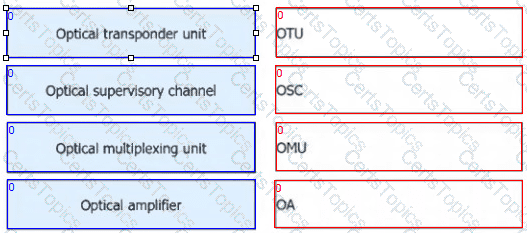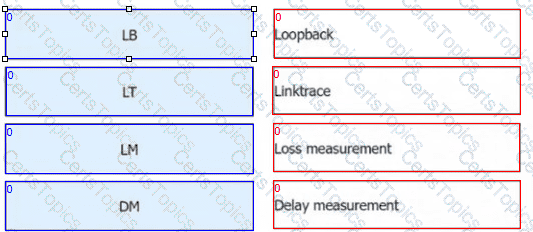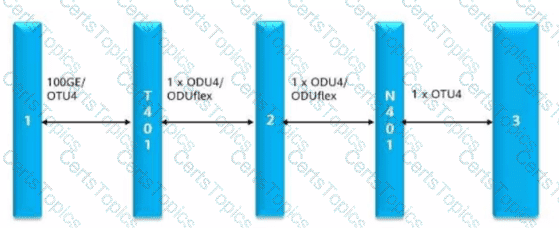Drag the functional units of a WDM system to corresponding abbreviated module names.

Select the correct on-demand OAM type based on the description for the blank area.

Which of the following is not an advantage of WDM?
Select the correct protection subtypes according to the descriptions.

When light passes through a passive optical component, the optical power decreases. This decrease is called an insertion loss.
In a coherent system, the incident optical power reference point in non-standard incident optical power is the output port of the OA board at the transmit end.
OTUk_DEG indicates OTUk signal degradation. Which of the following statements about the bit error detection mode are true? (Choose all that apply.)
The decrease of optical power when light passes through a passive optical component is called the____. (Enter only letters.)
After a device is powered on, what need to be checked on subrack fans? (Choose all that apply.)
After GE services enter the client side of an OUT board that supports Ethernet services, they are encapsulated into OTN or SDH signals by the signal processing module. The alarm signals are processed in the same way between encapsulation into OTN signals and encapsulation into SDH signals.
When the TTI to be received at the PM layer is inconsistent with the TTI actually received at the PM layer, which of the following alarms will not be reported?
Which of the following statements about a TNG2WSMD09 board aretrue? (Choose all that apply.)
WDM systems generally use DCMs to compensate for chromatic dispersion. Which of the following statements about DCM-based dispersion compensation is false?
In the electrical-layer structure of OTN, which of the following Is the path layer sequence from the signal input on the WDM side to the signal output on the client side?
The single wavelength incident optical power of a 100G system is lower than that of a 10G system. When 100G channels are expanded In a 10G system, the OA gain can be reduced to decrease the single-wavelength output optical power of the OA to meet the incident optical power requirements.
The EDFA amplifies service signals and brings noise to the system. It is the main source of noise.
In an OA system, the lower threshold of the receive optical power of a line board (with a PIN receiver laser) or the WDM side of an OTU board is the optical module's receiver sensitivity plus 5 dB.
Unlike ROADM, FOADM has some disadvantages. What are the disadvantages of FOAM? (Choose all that apply.)
In an OA-free system, the lower threshold of the receive optical power of a line board or the WDM side of an OTU board Is the optical module's receiver sensitivity plus 3 dB.
Drag the correct answer to the corresponding number in the picture.


The OA module inside an EMR8 board provides the____function. With this function, when one or more channels are added or dropped or optical signals of some channels fluctuate, the signal gain of other channels is not affected, (Enter only lowercase letters.)
Which of the following emulation modes are supported by CES services carried by PWE3? (Choose all that apply.)
Which of the following is not a difference between MPLS-TP OAM and MPLS OAM?
When a GE service is encapsulated into an OTN frame structure and an SDH frame structure, the alarms reported by client-side devices are different.
On a WDM network, if OA and OSC board in two directions report optical loss alarms, which of the following is the most likely cause?
OOS overheads are optical-layer overheads. Which of the following statements about OOS overheads is false?
Which of the following statements about user side interfaces and network-side interfaces of E-Line services are true?
QPSK modulation reduces OSNR requirements and fiber non-linear effects, and Improves dispersion tolerance and PMD tolerance.
Modulation is a process where the information of a signal source is processed and added to a carrier to make the information suitable for channel transmission. It is a technology where a carrier changes with a signal.
FILL BLANK
ODUk SNCP has three subtypes: _____, ______, and _____. (Enter the acronyms in uppercase letters.)
The OTUk_LOM alarm is generated when the out of multiframe (OOM) state lasts for 3 ms.
Which of the following statements about optical multiplexer and demultiplexer boards is false?
SOTU represents a single-OUT interface, and MOTU represents a multi-OUT interface.
OTUCn and ODUCn implement the functions of the digital section and channel layer.
For hybrid transmission of 100G-and-beyond and 10G signals, it is recommended that the optical power of 100G and beyond signals be higher than that of 10G signals but not higher than the single-wavelength nominal value of an OA board.